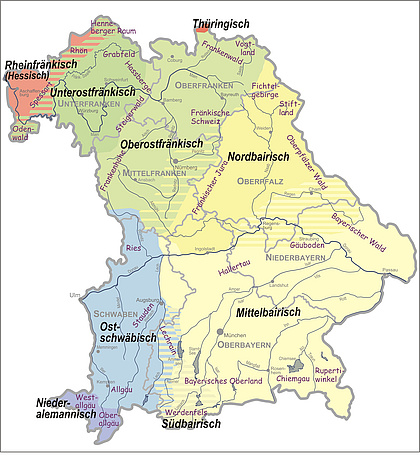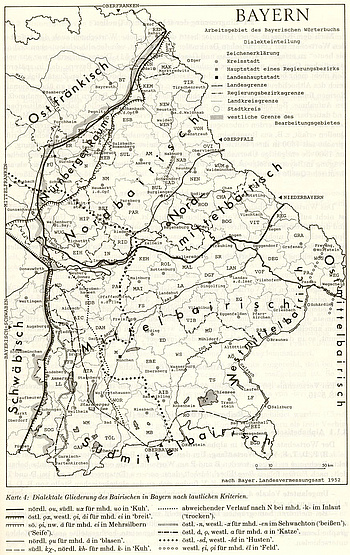“Bairisch” versus “Bayerisch”
When speaking of the dialect, “bairisch” is written with an “I”. Since King Ludwig I of Bavaria, a great fan of all things Greek, introduced the letter “Y” to Bavaria in the early C.19., one can differentiate: the spelling “bayerisch” refers to the geographical and political structure of today’s Free State, whereas the spelling “bairisch” refers to a certain type of dialect, spoken in Old Bavaria, in Austria and beyond.
The larger part of the Bairisch-Bavarian geographical area is not actually in Bavaria, but in Austria. Moreover, not only Bairisch-Bavarian dialects are spoken in the Free State of Bavaria, but also Swabian-Alemannic, East Franconian and even the Palatine dialects. The type of dialect called Bairisch-Bavarian in turn is spoken in Austria, South Tyrol and (at least in vestiges) in the Bohemian Forest. In respect of its geographical size and number of speakers, Bairisch-Bavarian is the most widespread of the German dialects, spoken by around five million Bavarians and six million Austrians, not counting South Tyroleans and other minorities.
Dialectal Structure of Bavarian
The Bavarian dialect area is divided into South, Middle and North Bavarian. The core region of conservative South Bavarian is located in Tyrol and Carinthia, outside of Bavaria. The Middle Bavarian dialect area includes the larger part of Upper and Lower Bavaria with the valleys of the Danube, Isar and Inn, as well as eastern parts of Bavarian Swabia. North Bavarian is spoken in the Upper Palatinate and neighbouring regions of Middle and Upper Franconia. In the south, North Bavarian extends to the Danube. Between these main regions and the neighbouring Swabian and Franconian vernaculars there are transitional zones, especially in the Lechrain and the Nuremberg area.
Research Scope of the Bayerische Wörterbuch
In the east and south, the area covered by the dictionary is limited by the state border with Austria. In the south west, the River Lech is the border to Swabian. Settlements of the old district Füssen, on the east side of the Lech, are not included.
In the North, area is delimited by the North Bavarian „tipped“ diphthongs Bou, Breif (Middle High German buobe „Bub“, brief „Brief“) and the diphthongization of the long â to ǫu in blǫusn „blasen“ (from MHG blâsen). The Nuremberg transitional zone to the East Franconian dialects also has these features, and is thus included in the Bayerisches Wörterbuch.
See also Digitales Informationssystem für Bayerisch-Schwaben (DIBS) and Fränkisches Wörterbuch (WBF).


